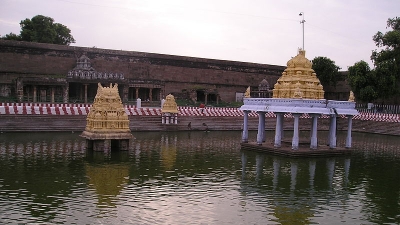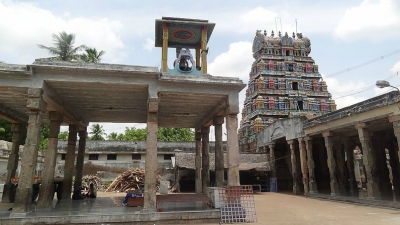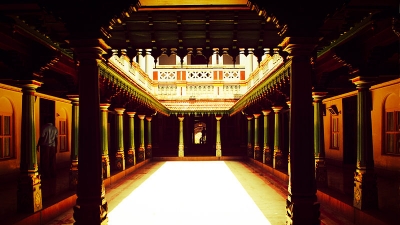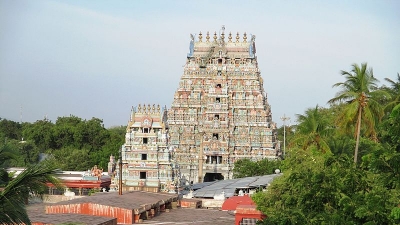Mayiladuthurai Attractions - Tourist Places To Visit In Mayiladuthurai
-
01Mayuranathaswami Temple
 + Read More
+ Read MoreMayuranathaswami Temple is often referred to as the big temple of Mayiladuthurai. Mayuranathaswami, literally husband of Mayuram, is the presiding deity of the temple. Legend says that Parvati fell out of favour with Lord Shiva and because of his ensuing anger, Shiva cursed Parvati to be born as a peahen.
Mayura, an incarnation of Parvati, worshipped and appeased Lord Shiva at Mayiladuthurai at the site of the temple. The idol in the temple is depicted as worshipping the lingam, telling the story of Mayiladuthurai for all to see. The oldest inscriptions on the temple walls date back to the time of the Kulothunga Chola.
The temple renovated after its initial construction stands to this day as a testimony to the architectural genius of the Cholas. Mayura Natyanjali, an annual dance festival conducted in the premises of the temple dedicated to Lord Natarajan, is a crowd-pleaser.
The festival is organised by the Sapthaswarangal Trust during Maha Shivarathri along the lines of the Chidambaram Natyanjali festival. Visitors partake in a visual treat of classical dance forms performed on ancient land.
-
02Dakshinamoorthy Temple
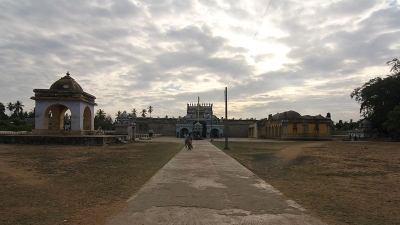 + Read More
+ Read MoreDakshinamoorthy Temple in Mayiladuthurai depicts Lord Shiva as a guru, a teacher, somebody who endows knowledge. This form of Shiva as Dakshinamoorthy is especially popular in Tamil Nadu and other Southern parts of the country. Dakshinamoorthy literally translates as ‘one who is facing south’.
In every Dakshinamoorthy temple, the idol is positioned southwards as against idols that are usually positioned eastwards. The Dakshinamoorthy idol is usually depicted as having four arms, placed under a banyan tree. His right leg lies on a mythical apasmara (a demon who is the embodiment of ignorance) and his left leg lies folded on his lap.
His hands hold a flame in one hand and a rosary or a snake or both in the other hand. His right hand is usually depicted in the Gnana mudra (a symbol of wisdom and knowledge) and his left hand in Abhaya mudra (a symbol of blessings and assurance).
Shiva is rarely depicted as Dakshinamoorthy and a whole temple dedicated to Dakshinamoorthy being even rarer, the temple in Mayiladuthurai is definitely worth a visit.
-
03Sri Parimala Ranganathaswami
 + Read More
+ Read MoreSri Parimala Ranganathaswami Temple located on the banks of the river Cauvery is one of the 108 temples of Vishnu (Vaishnava Thirupathis or Divya Desams) revered by the Vaishnavite poets, the alwars.
Sri Parimala Ranganathaswami, an incarnation of Lord Vishnu is personified in this temple in a 12 foot idol made of green stone. Lord Vishnu’s consort Parimala Ranganayaki is variously known as Chandra-shapa-vimochanavalli and Pundarikavalli.
Legends say that the Goddess absolved Chandra of his curses at this holy site; hence, the name Chandra-shapa-vimochanavalli. The temple although significant by itself, is a part of a religious pilgrimage circuit called the Pancha Ranga Kshetram. The Pancha Ranga Kshetram literally translates as the five Vishnu temples.
The temples follow the course of the river Cauvery, beginning with Sri Ranganathaswami Temple in Srirangapatnam, Sri Ranganathaswami Temple in Srirangam, Sarangapani Temple in Kumbakonam, Sri Appakkudathan Temple in Trichy and finally Sri Parimala Ranganathaswami Temple in Mayiladuthurai.
-
04Sri Kasi Vishwanathaswami Temple
 + Read More
+ Read MoreSri Kasi Vishwanathaswami Temple, on the banks of the river Cauvery on the Thula ghat is renowned for being the “Kashi of the South”. The name Vishwanathaswami translates into the Ruler of the Universe hinting at the power and omnipresence of Lord Shiva.
Pilgrims who for various reasons cannot go to Kashi Vishwanath in Varanasi, come to Sri Kasi Vishwanathaswami temple in Mayiladuthurai. A visit to Kashi Vishwanath and a dip in the Holy Ganges is widely believed to absolve devotees of sins and set one on the right path to attain Moksha.
Devotees from across the nation embark on the Kashi pilgrimage at least once in their lives. The dissolution of a loved one’s ashes in the Ganges at Kashi is believed to help the soul’s journey into the after-life. Staunch devotees believe that Lord Shiva himself repeats the Mantra of Salvation to a devotee if his or her ashes are dissolved in the Ganges at Kashi.
The temple on the banks of the river Cauvery is widely held as being just as holy and powerful as the temple in Varanasi. Dhondi Vinayaka and Bhairava are enshrined in this temple alongside Lord Shiva and his consort Parvati Devi.
-
05Thula Utsavam
 + Read More
+ Read MoreThula Utsavam is a month long festival that takes place every year at Mayiladuthurai. The festival during the Holy month of Aippasi (between mid-October and mid-November) sees thousands if not lakhs of devotees visit Mayiladuthurai. Similar to the Kumbh Mela in the North, Thula Utsavam on the banks of the river Cauvery draws devotees from South India.
The last day of the Holy month Aippasi, Kadaimugam is a celebration unlike any other. It is believed that the Holy rivers Ganges, Yamuna and Saraswathi come to the mighty Cauvery for a cleansing ritual such that they may be recharged and ready to imbibe the sins of the believing devotees who take a dip in their waters.
A holy bath on this day is of significance to devotees as the four holy rivers are said to converge in one place. The day before the Holy month of Aippasi ends, chariot festivals reign the streets of Mayiladuthurai. Deities from the Vallalar Temple, Mayuranathaswami Temple and Ranganathaswami Temple are taken around the town in chariots that are decorated specifically for the occasion.
-
06Sri Vadhanyeshwarar Temple
 + Read More
+ Read MoreSri Vadhanyeshwar Temple, located on the northern bank of Cauvery, is also commonly known as Vallalar Kovil. The temple dedicated to Lord Shiva has a legend associated with it. As the legend holds, Lord Shiva was disappointed that Nandi Deva was proud that he was the one who bore Lord Shiva. The lord then decided to teach Nandi humility by making a single lock of his hair so heavy that Nandi Deva could not bear the weight on his back. The idol in the shrine of Sri Medha Dakshinamurthy is portrayed as a yogi sitting in a yoga asana on Nandi deva.
The idol’s right hand is depicted as being in the Jnana Mudra and his left hand is depicted as holding a book. Apart from the history associated with the temple, the sheer beauty of the locale attracts a lot of tourists. The sweeping uninterrupted view of the river Cauvery from the temple revives respect for nature in the onlooker.
-
07Punugiswarar Temple
 + Read More
+ Read MorePunugiswarar Temple, located in Koorainadu, is dedicated to Lord Shiva and his consort Santha Nayaki. The temple gets its name from Punnakku Siddhar, who attained moksha here. Mayiladuthurai has been home to numerous saints, called siddhars. Literary works, like Mayiladuthurai Mahaangal, talk about the saints who lived in and around the town. A village on the outskirts of Mayiladuthurai is called Sitharkadu to this day because of the many saints who lived there once upon a time. Like the temple town of Kanchipuram, the town of Koorainadu has significance outside of religion in the textile industry. While Kanchipuram is synonymous with Kanchi silk saris, Koorainadu is famed for weaving two lengths of nine yard saris without a joint.
"Koorai" translates as "cloth" in Tamil, reinstating how inextricable Koorainadu and saris are. It is believed that when the weavers of Koorainadu suffered because of drought, the Brahmins promised to buy one sari for every wedding so they may find some measure of relief. Most traditional Iyer weddings till date find the bride in a Koorai sari.
-
08Gangaikonda Cholapuram
 + Read More
+ Read MoreGangaikonda Cholapuram was established by Rajendra Chola to memorialise his conquest of the Pala dynasty. The city served as the capital of the Chola dynasty for nearly 250 years. The name literally translates into the town of the Chola who defeated the Ganges. Not much of the town that was once the capital of an empire survives to this day. The opulence of the Shiva temple is but a shadow of what the capital city was during the eleventh century. The Shiva temple in the capital city took a total of nine labour-intensive years to build. The temple survives to this day as an excellent example of the superior art and architecture of the Cholas. The temple is not only significant for being a Chola temple, but also for being the only temple in South India with the biggest Shivalingam. A four-metre-high lingam graces the sanctum sanctorum of the temple.
Meticulous accounts of the Chola dynasty and their kingdom depicted in inscriptions on copper plates on the walls of the temple provide a glimpse into history far more interesting than any textbook interpretation of the Chola dynasty. Beautiful carvings, awe-inspiring architecture and the astounding age of the temple (nine hundred and eighty-four years old) make the Gangaikonda Cholapuram a destination that has to be experienced.
-
09Sri Ayyarappar Temple
 + Read More
+ Read MoreSri Ayyarappar Temple in Mayiladuthurai, like the Gangaikonda Cholapuram Temple, is of archaeological importance. While the Gangaikonda Cholapuram Temple built by the Chola King Rajendra and has copper plates with inscriptions about the Chola dynasty on the temple walls, Sri Ayyarappar Temple has numerous stone inscriptions about the Kulothunga Chola period. The Kulothunga Chola kings were famed for their festivals. Every year, 12 festivals were conducted with great pomp and circumstance, one every month of the year.
The presiding deity in the temple is Dharmasamvardhani, which literally translates into the upholder of Dharma. The stone inscriptions in the temple of the Kulothunga Chola period are not very clear, they do, however, convey broken images of the resplendent age that the Kulothunga Chola lived in. Being in places of age and character, like temples, tend to connect an individual to nature, like pieces of a long-lost puzzle.
-
10Kurukai Sivan Temple
 + Read More
+ Read MoreKurukai Sivan Temple in Mayiladuthurai is a Shiva temple that depicts Shiva with his third eye open. The temple is believed to be the place where Shiva opened his third eye to burn Manmathan. Shiva is famed as having terrible anger that destroys everything in his line of sight. An important physical feature about Shiva is his third eye, as revered as it is feared.
The legend of Lord Shiva’s third eye is told in the epic ‘Mahabharatha’. Parvati playfully closed Shiva’s eyes from behind him. When the Lord of the Universe’s eyes were closed, the world was engulfed in darkness. It was then that a flame leapt from Shiva’s forehead, an eye appeared that gave light to the World again.
The third eye is known to only look inward, when the eye does look outward it is destructive. It is because of Shiva’s third eye and his anger that Manmathan, the Lord of love was reduced to ashes. The temple of Shiva, also known as trinethra, triambaka, triaksha and trinayana, seems to remind the ordinary mortal of Lord Shiva’s anger and his immense power.



 Click it and Unblock the Notifications
Click it and Unblock the Notifications

